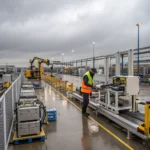Operational efficiency is no longer a luxury—it's a business imperative in today’s rapidly evolving market landscape. Organizations are under constant pressure to reduce costs, improve productivity, and respond faster to changing customer expectations. To stay competitive, businesses are turning to artificial intelligence (AI)—not just as a tool, but as a catalyst for reimagining operational workflows and achieving unprecedented levels of efficiency. By integrating AI across core business functions, organizations can automate repetitive tasks, make smarter decisions, and scale their operations with agility and precision.
How AI is Reshaping Operational Efficiency
AI plays a pivotal role in enhancing operational efficiency by eliminating inefficiencies and enabling faster, data-driven decisions. One of its key benefits lies in automating routine tasks—such as data entry, transaction processing, and simple customer interactions—using Robotic Process Automation (RPA). This frees employees to focus on higher-value initiatives, thus improving both productivity and job satisfaction.
Another major advantage is AI’s ability to process vast amounts of data in real-time, uncovering patterns and insights that might otherwise go unnoticed. Through predictive analytics, businesses can anticipate demand fluctuations, identify risks before they escalate, and optimize resource allocation accordingly. This combination of speed, accuracy, and intelligent scalability transforms operations into proactive, rather than reactive, engines of growth.
AI in Action: Real-World Operational Transformations
Several forward-thinking companies have harnessed AI to revolutionize their operational efficiency. UPS, for instance, uses AI-powered tools to forecast delivery disruptions and optimize routing. By analyzing traffic patterns and package loads, UPS ensures on-time delivery while reducing fuel consumption and labor costs.
In the agricultural sector, John Deere leverages AI in precision farming. Machine learning algorithms guide equipment to optimize planting, irrigation, and harvesting, leading to better yields and efficient resource usage. This not only increases profits but also promotes more sustainable farming practices.
Healthcare innovator VideaHealth is applying AI to enhance diagnostic accuracy and standardize dental care workflows. Their platform analyzes medical images to support clinical decisions, reducing diagnosis time and maintaining high standards across practitioners.
Core Technologies Powering Efficiency Optimization
The backbone of AI-driven efficiency lies in several advanced technologies. Machine Learning enables systems to learn from historical data and optimize decisions with minimal human intervention. Over time, models become increasingly accurate, making them ideal for forecasting and anomaly detection.
RPA focuses on automating structured, repetitive processes like invoicing, data syncing, and report generation. It’s especially useful in reducing processing times and ensuring task consistency. Natural Language Processing (NLP), on the other hand, facilitates better communication between humans and machines. It powers smart document processing tools and intelligent chatbots that handle customer inquiries around the clock.
Computer Vision is making waves in manufacturing, where it’s used for quality control. Cameras paired with AI models can detect product flaws in real time, reducing waste and ensuring high standards across production lines. These technologies, when orchestrated together, lay the foundation for intelligent automation at scale.
Strategic AI Applications Across Key Business Functions
Across departments, AI is reshaping how decisions are made and actions are executed. In supply chains, AI systems analyze equipment performance to enable predictive maintenance, reducing downtime and costly repairs. AI-powered forecasting models make inventory and demand planning more accurate, leading to leaner operations.
In Human Resources, AI assists in talent acquisition, employee training, and performance monitoring. Machine learning can tailor training programs based on employee performance data, enhancing skill development and boosting workforce productivity.
Customer service is being transformed with AI-driven chatbots, virtual assistants, and sentiment analysis tools. These technologies deliver round-the-clock support while enabling human agents to handle more complex issues. Finance departments are using AI for real-time fraud detection, credit risk assessment, and compliance monitoring, reducing human error and increasing security.
In manufacturing, AI drives smart scheduling and inventory control. Algorithms determine the most efficient production timelines and ensure raw materials are sourced just-in-time, reducing storage costs and production bottlenecks.
AI-Driven Business Process Automation & Integration
The concept of hyperautomation—integrating AI, RPA, and machine learning across all business processes—is redefining how companies approach long-term efficiency. Rather than siloed AI applications, hyperautomation connects various tools and systems, enabling end-to-end workflow automation.
Embedding AI into systems like CRM, ERP, and cloud-based platforms ensures seamless data flow and unified decision-making across departments. This integration not only streamlines operations but also delivers measurable outcomes such as reduced costs, improved accuracy, and mitigated risk.
Businesses that adopt these automation strategies often report benefits such as faster service delivery, lower operational errors, and more resilient operations. It's a shift from reactive management to predictive and adaptive operations.
Enabling a Scalable AI Strategy for Long-Term Success
To build a future-ready, AI-powered organization, having the right foundation is crucial. High-quality, structured data is at the heart of any successful AI initiative. Without clean and consistent data, algorithms cannot deliver reliable insights.
Equally important is a secure, scalable infrastructure that supports real-time processing and machine learning model deployment. Ethical considerations, such as data privacy, transparency, and bias mitigation, must also be integral to AI deployment strategies to comply with regulatory standards and build stakeholder trust.
Fostering a cross-functional culture that embraces innovation is key to successful adoption. From pilot projects to department-wide rollouts, business leaders must coordinate efforts across IT, operations, and leadership teams. This organization-wide approach not only encourages collaboration but accelerates digital transformation efforts.
Future Trends in AI-Powered Operational Efficiency
Looking ahead, generative AI (GenAI) will unlock new opportunities for personalized automation and decision support. By generating content, code, or insights autonomously, GenAI enhances creative and strategic business processes.
Predictive analytics will grow more robust, enabling businesses to plan for market changes, customer behavior shifts, and operational disruptions with greater confidence. The future will also emphasize responsible AI, as organizations prioritize fairness, explainability, and regulatory compliance in their strategies.
Low-code and no-code AI platforms are on the rise, offering business users tools to experiment and innovate without needing deep technical expertise. These tools democratize AI development, allowing companies of all sizes to reap its benefits.
Conclusion: Embracing AI for Sustainable Competitive Advantage
AI is not just a technology trend—it’s a transformative force that redefines operational efficiency across every industry. From automation and predictive analytics to intelligent process design, AI empowers organizations to operate faster, smarter, and more resiliently.
Incorporating AI into your core operations isn’t just about keeping up—it’s about leading the way forward in a data-driven world. Whether your business is just starting out or scaling digital transformation efforts, now is the time to leverage AI to future-proof your operations and secure long-term success.
Start today, and position your business at the forefront of tomorrow’s intelligent economy.

![leveraging-ai-for-next-level-operational-efficiency-ai-operational-efficiency-next-level-operations Leveraging AI for Next-Level Operational Efficiency - [AI, Operational Efficiency, Next-Level Operations]](https://apexworkflows.com/wp-content/uploads/2025/06/make639154508-1024x638.webp)




